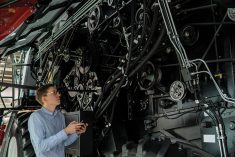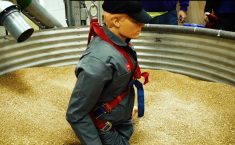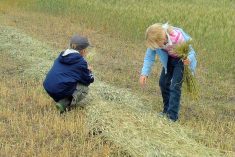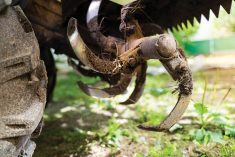Donna Noble knows all too well how life can change in an instant.
In April 2008, her 17-year-old daughter, Jenny, was killed in a school bus accident outside of Rimbey, Alta. But a month after Jenny’s death, Noble, a volunteer firefighter, was back on the trucks.
“I went back with the belief that I couldn’t help Jenny, so I’m going to help someone else,” explains Noble. “And I haven’t stopped since.”
Read Also

Gentle treatments for pain in the neck
Heading toward year-end, people unknowingly tense up against the cold and busyness, causing neck pain that can often be treated with appropriate support and gentle mobility, athletic therapist Kathlyn Hossack says.
That desire to help others and keep Jenny’s memory alive is a large part of why Noble, who represents two fire departments within Ponoka County Regional Fire Services, has become a dedicated training instructor.
“I’m a very passionate instructor. To see my students succeed and know I have given them the opportunity to help the community is very heartwarming,” Noble says, noting the fire department that responded to Jenny’s accident is now where she’s a lead instructor and training captain.
One of the training programs that Noble is particularly passionate about is the Canadian Agricultural Safety Association’s BeGrainSafe program, which provides training for fire departments on how to respond to grain entrapments, along with other grain safety education and training initiatives.
Now a master trainer with BeGrainSafe, Noble says the grain rescue training the program provides is invaluable in rural communities.
“The BeGrainSafe program prepares us because just like not every fire call is the same, not every grain rescue is the same, but the risks are still there,” says Noble.
“Grain engulfments don’t happen very often, thankfully, but when they do, they are extremely high risk. And it’s important to remember the risks aren’t only for the person you’re trying to rescue, but also for the firefighters conducting the rescue.”
Having trained 81 trainees at four different BeGrainSafe sessions so far, Noble says she has noticed many people who take the course leave with a new perspective and respect for the risks associated with grain.
“There was one grain rescue training session I conducted with our local fire service and a few of the participants were saying, ‘I’ve dealt with grain all of my life, what’s the big deal?’ And by the time we were done they had a whole new understanding and appreciation for grain safety,” Noble explains.
“People are always surprised about the hazards of grain and what goes into a grain rescue operation. I hear a lot of comments from people saying they never would have guessed how easily they could be completely helpless in grain. They realized that with a grain engulfment, you’re at the complete mercy of someone else to rescue you.”
Of course, BeGrainSafe trainees aren’t the only ones with misconceptions about grain safety. And eradicating the misperceptions about grain hazards is why programs like BeGrainSafe are so important. As Noble says, it all comes down to building awareness.
“Grain safety is pertinent right across the country,” she explains. “We need to continue to spread education and awareness about grain safety, and I take a lot of pride in helping bring that awareness to our local communities and farmers.”
Noble mentions the effect grain rescues and recoveries have on communities is something that can’t be overlooked. She points to the tragic grain entrapment near Condor, Alta., that took the lives of three young sisters and affected neighbouring farming and firefighting communities.
“Whether or not you knew people involved in these tragedies, it’s still part of the community — both the farming community and the fire department community. You’re there to support one another,” Noble explains. “This is a farming community, so I can’t say it’s a matter of if we’ll ever be called to a grain rescue, but when. And that’s why this training hits close to home for all of us.”
That’s also why Noble says the grain rescue training never stops. Even when the BeGrainSafe trailer, which facilitates grain entrapment and rescue simulations, isn’t available, Noble makes sure local fire departments continue to expand their skills and awareness around grain safety.
“Just because the (BeGrainSafe) trailer isn’t here doesn’t mean the grain safety education and awareness stops. Instead, we build upon the training. You can still discuss the theory, you can still discuss the auger, you can still discuss the rescue tubes and you can tour a farm or other operation,” she explains. “You keep the learning going so they don’t forget those skills. Because this isn’t something we want to become rusty on.”
There’s no question Noble’s enthusiasm for training is infectious. And, fortunately, she sees no end to helping spread awareness about grain safety and other issues to safeguard the community while keeping Jenny’s memory alive.
“The more I can train, the happier I am. I love giving back to the community, especially with a program like BeGrainSafe where everyone benefits,” says Noble. “The BeGrainSafe program gives us another tool in the toolbox. We hope we never have to use it, but the more tools we have to keep the community safe, the more people we can help.”
For more information on the BeGrainSafe program, please visit casa-acsa.ca/BeGrainSafe.
– Erin Kelly for the Canadian Agricultural Safety Association.















